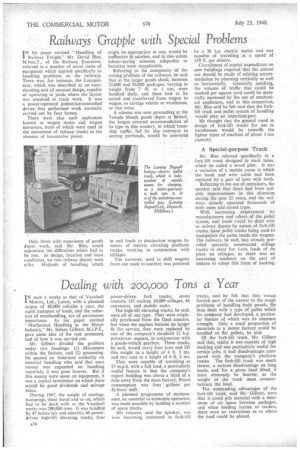Railways Grapple with Special Problems I N his paper entitled "Handling of
Page 52

If you've noticed an error in this article please click here to report it so we can fix it.
Railway Freight," Mr. David Blee, M.lnst.T., of the Railway Executive, referred to a number of novel items of equipment which applied specifically to handling problems on the railways. There was, for instance, the Locopulsem, which was described as an autoshunting unit of unusual design, capable of operating in yards where the layout was unsuited to truck work. It was a power-operated pedestrian-controlled device that performed work normally carried out by four horses.
• There were also such appliances known as wagon mules and wagon traversers, both of which were used in the movement of railway trucks in the absence of locomotive power.
Only those with experience of goods depot work, said Mr. Blee, could appreciate the difficulties which had to be met. In design, location and local conditions, no two railway depots were alike. Methods of handling which might be appropriate in one, would be ineffective in another, and to this extent labour-saving schemes adaptable to factories Were inapplicable.
Referring to the complexity of the , sorting problem of the railways, he said that at the larger goods sheds, between 25,000 and 50,000 packages, varying in weight froin 7 lb. to 1 ton, were handled daily, and these had to be sorted and transferred from wagon to wagon, to cartage vehicle or warehouse, or vice versa.
A scheme was now proceeding at the Temple Meads goods depot at Bristol, the largest covered accommodation of its type in this country, in which transship traffic, fed by slip conveyor to sorting pierheads, would be conveyed in unit loads to destination wagons by means of electric elevating platform trucks, working in conjunction with stillages.
The traverser, used to shift wagons from one track to another, was powered by a 30 h.p. electric motor and was capable of travelling at a speed of 350 ft. per minute.
Curtailment of capital expenditure on new buildings required that the utmost use should be made of existing accommodation by planning vertically as well as horizontally. Generally speaking, the volume of traffic that could be stacked per square yard could be materially increased by the use of mechanical appliances, and in this connection, Mr. Blee said he felt sure that the forklift truck and pallet system of handling would play an important part.
He thought that the general trend in design of fork-lift trucks for use in warehouses would be towards the lighter types of machine of about I-ton capacity.
A Special-purpose Truck Mr. flee referred specifically to a fork-lift truck designed to stack bales, which he called a wood piler. It was a variation of a mobile crane in which the hook and wire cable had been replaced by a pair of jaws with teeth,
Referring to the use of containers, the speaker said that there had been notable improvements in this direction during the past 22 years, and the railways already operated thousands of both open and closed types.
With increasing employment by manufacturers and others of the pallet system, unit loads could be dealt with at railway depots by means of fork-lift trucks, hand pallet trucks being used to manipulate the pallet inside the wagons. The railways, he said, had already provided specially constructed stillage trucks to cater for 1-ton loads of tin plate on stillages, as there was an increasing tendency on the part of makers to adopt this form of packing.




















































































